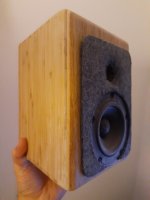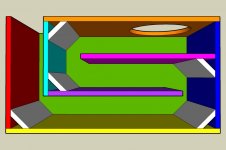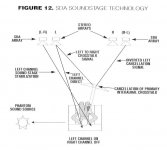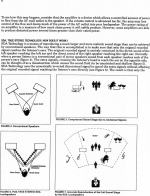Very interesting. Felt or jaguar fur on front baffle? Felt In front seems like a popular choice.. I'll draw up a sketch in a bit. These are kind of 2.5 way speakers. I need to put a wall between the left most pair and right most pair.
I'll also be using one passive radiator for left array of 2 speakers and a passive radiator for right array of 2 speakers.
Wanr to separate the.midrange only pair of drivers from midrange+bass pair of drivers
I'll also be using one passive radiator for left array of 2 speakers and a passive radiator for right array of 2 speakers.
Wanr to separate the.midrange only pair of drivers from midrange+bass pair of drivers
Look up the "Variera" or "UPPDATERA" boxes from Ikea.
They are quite pretty, suitable for small speakers, and have non-parallel surfaces.
I made a simple little speaker (pictured) with a Variera + cutting board (for the front panel) + felt.
If you added some internal angles & a resin goo layer, that would be a nearly "ideal" speaker enclosure, that doesn't need elite wood skillz.
Or you could glue glue two of these together to make a bigger hexagonal enclosure:
UPPDATERA Tray with knife rack, light bamboo/anthracite, 20x50 cm - IKEA
The knife racks, with some DIY modifications, (AKA "kitbashing") could become a cheap DIY version of that B&W concept from post 8.
They are quite pretty, suitable for small speakers, and have non-parallel surfaces.
I made a simple little speaker (pictured) with a Variera + cutting board (for the front panel) + felt.
If you added some internal angles & a resin goo layer, that would be a nearly "ideal" speaker enclosure, that doesn't need elite wood skillz.
Or you could glue glue two of these together to make a bigger hexagonal enclosure:
UPPDATERA Tray with knife rack, light bamboo/anthracite, 20x50 cm - IKEA
The knife racks, with some DIY modifications, (AKA "kitbashing") could become a cheap DIY version of that B&W concept from post 8.
Attachments
Very interesting. Felt or jaguar fur on front baffle?
They are probably very similar acoustically, but most people use felt - fur is very niche, aesthetically 🙂
Look up "Dunlavy" speakers for a high end commercial example.
I had a GF who really liked fur, so I made her some speakers wrapped in vivid monster fur. They also had curved, sand-filled walls, which is not what I'd do now (a resin + goo mix is better / more stable / damage proof).
I am not super handicap in carpentry. Can built something that resembles a transmission line.
What if I use this transmission line design and instead of the port use passive radiators. I used few speaker design apps to match passive radiators with the drivers I use. But would a transmission line be a significant improvement over just adding an angled board inside the cabinet?
What if I use this transmission line design and instead of the port use passive radiators. I used few speaker design apps to match passive radiators with the drivers I use. But would a transmission line be a significant improvement over just adding an angled board inside the cabinet?
Attachments
Read a little about transmission lines it sounds like a much more complex project than slapping together a maze.
"Read a little about transmission lines it sounds like a much more complex project than slapping together a maze."
Yeah. As a noob, either:
1) keep it simple.
e.g. full range + woofer (like what planet10 makes commercially)
or
DIY sub + satellite (same basic idea)
...is relatively easy to get right.
2) copy an existing design, pretty closely.
Yeah. As a noob, either:
1) keep it simple.
e.g. full range + woofer (like what planet10 makes commercially)
or
DIY sub + satellite (same basic idea)
...is relatively easy to get right.
2) copy an existing design, pretty closely.
Well basically I am using Polk sda 2a cross overs and replacing the woofers with much better dynaudio 17w75xl drivers. The drivers closely match the original Polk drivers.
That's why the position of woofers is two arrays parallel vertically. Ideally distance between centers of woofers needs to be equal to distance between ears.
I like the wide sound stage.. but the original speakers sound s little muddy in upper midrange..some frequencies are recessed. 17w75xl drivers seem to do much better job than original Polk drivers. I got the dynaudio drivers for free and have tons of free mdf. The cost is basically glue, time + wear and tear in carpentry equipment, and new film capacitors for cross overs.
What do people outside Polkaudio forums think of these speakers?
That's why the position of woofers is two arrays parallel vertically. Ideally distance between centers of woofers needs to be equal to distance between ears.
I like the wide sound stage.. but the original speakers sound s little muddy in upper midrange..some frequencies are recessed. 17w75xl drivers seem to do much better job than original Polk drivers. I got the dynaudio drivers for free and have tons of free mdf. The cost is basically glue, time + wear and tear in carpentry equipment, and new film capacitors for cross overs.
What do people outside Polkaudio forums think of these speakers?
Attachments
Last edited:
Isn't that only so at higher frequencies? Though as a counterpoint, what I recall about rounding the baffle edges from some long-ago AES paper is that the roundover should be like 4."For a simple box, felt on the front baffle does approximately the same thing as rounding the baffle edges.
+1 to the rest of what you said; the shape is really affecting more the mid and upper frequencies.
e.g. full range + woofer (like what planet10 makes commercially)
Just plans.
dave
I remember listening to those. The SDA concept as a theoretical "fix" is nonsense,* however the effect can be very nice (particularly with certain classical music recording techniques someone once defensively posted) and the speakers had a clear sound.What do people outside Polkaudio forums think of these speakers?
Of course the SDA crossovers won't be optimized for your Dynaudio drivers but what the heck, give it a go. Maybe you can Zobel the Dynaudios to match the original Polk impedance.
I do not believe there is any need to have an empty space V, or even a V at all. I would put one slim baffle piece inside crookedly, to minimize any common dimensions. Kinda like post #13, but only one part of the V, and with more breathing room around it. The stuffing is perhaps more important really. Pillow stuffing/polyester is not the greatest. Vance Dickason's seminal Loudspeaker Design Cookbook - Meniscus Audio has a section where he tests the effect of different fill materials on midrange absorption.
*because gee the records are MIXED with cross-talk in the first place!
Impedance of 2 dynaudio In series matches perfectly with 1 original Polk 8ohm
Plus q, compliance, bl numbers are very close.
Woofer and tweeter volumes are matched to my liking. I connected this set up in a spare box. Nothing odd or requiring a tweak. Much cleaner midrange with dynaudio.
Very interesting point about sda. But don't quite understand the cross talk introduced during a recording. Isn't a microphone a small dot in space and it's not really getting and sound bleed from left or right.
Would you elaborate on why sda is non sense as a fix to cross talk. Hard to find critique of this effect.
Plus q, compliance, bl numbers are very close.
Woofer and tweeter volumes are matched to my liking. I connected this set up in a spare box. Nothing odd or requiring a tweak. Much cleaner midrange with dynaudio.
Very interesting point about sda. But don't quite understand the cross talk introduced during a recording. Isn't a microphone a small dot in space and it's not really getting and sound bleed from left or right.
Would you elaborate on why sda is non sense as a fix to cross talk. Hard to find critique of this effect.
The simplest of these is to place damping material inside the box.
This!
Damping is not very effective on the lowest mode (of longest dimension) though, which one can prevent happening by placing the driver midway of the dimension. In addition to these, design your multiway speaker so that the standing waves fall out of band. Other measures seems unnecessary work to me currently.
All obstacles / slants / dividers you can fit inside the enclosure are not big enough to tackle the lowest modes and the damping material is effective for the higher ones so there is no need to put any structure in for the standing waves. There are some "exotic" solutions available though, like quarter wave resonance and what not. You could bake these into the speaker walls for example, to tackle a problematic frequency but it is just hard work to do so. Checkout insides of Yamaha ns5000 what they have come up with to differentiate.
Outside shape is much more important I think, as long as the inside doesn't cause audible problems.
Last edited:
I wouldn't agree, but you could prove me wrong?Damping is not very effective on the lowest mode (of longest dimension) though,
I find this most satisfying if I've hunted it myself.jaguar fur on front baffle?
Sorry, I don't even remotely agree based upon long experience in using stuffing and measuring. Most enclosures built on this site have the lowest internal mode well into the range where various forms of stuffing are very effective, providing you've thought about it's placement in the design stage.This!
Damping is not very effective on the lowest mode (of longest dimension) though, which one can prevent happening by placing the driver midway of the dimension. In addition to these, design your multiway speaker so that the standing waves fall out of band. Other measures seems unnecessary work to me currently.
Have you listened to miniOnken?
If not here's a new product just for you!
You will be amazed.
The best design I've ever heard.
Leif
If not here's a new product just for you!
You will be amazed.
The best design I've ever heard.
Leif
If you are addressing me, I seriously doubt it.Have you listened to miniOnken?
If not here's a new product just for you!
You will be amazed.
The best design I've ever heard.
Leif
AllenB, Brett, I should have written "as effective". As you both know the various materials "damping" depend on frequency and incident angle, thickness and possible gap between boundary. The trend is this, for any material except that are tuned resonators: around kHz any material sold as acoustic / damping stuff is rather effective but at 100Hz only about glass wool and comparable products are effective in a thickness that fits inside the enclosure.
Problems arise with large boxes used in two way configuration for example. A 42" tall box has first mode around 160Hz. Try and take that out with damping material if it falls into the pass band of said box and turns out to be a problem. Insulation might be enough and that is the best case scenario. Simplest thing to do and off we go to other more important issues.
Everything is relative to wavelengths and dimensions of course. If the longest dimension of a subwoofer box is 12" then anything goes.
Problems arise with large boxes used in two way configuration for example. A 42" tall box has first mode around 160Hz. Try and take that out with damping material if it falls into the pass band of said box and turns out to be a problem. Insulation might be enough and that is the best case scenario. Simplest thing to do and off we go to other more important issues.
Everything is relative to wavelengths and dimensions of course. If the longest dimension of a subwoofer box is 12" then anything goes.
Last edited:
- Home
- Loudspeakers
- Multi-Way
- Ideal speaker shape to make at home



